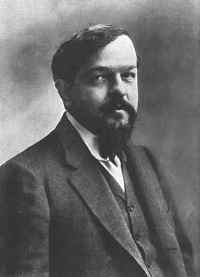
Claude Debussy was born in France in 1862. He began piano lessons at the age of seven. His talents were evident early on, and began studies at the Paris Conservatoire when he was only ten years old. There he studied composition, music history, music theory, harmony, piano, organ, and solfege for eleven years.
Debussy’s compositional style was always experimental; he loved dissonance and unusual intervals and tonalities. After graduating from the Conservatoire, he won the Prix de Rome, a composition competition, and was awarded a scholarship to study in Rome. There he was inspired by the musicality of Franz Liszt.
Other places he traveled influenced his musical style as well, such as Bayreuth, Germany, where he was impacted by Richard Wagner, and back to Paris for the Exposition Universelle, where he was exposed to Javanese gamelan music. He incorporated many unique scales, melodies, and textures that he heard in that type of music into his own.
Debussy’s style changed over time. His early style was dreamy and romantic, colored by the Symbolist trend of French literature, a movement of anti-realism. His middle period included a lot of imagery. Many of his works from this period were intended to depict a sort of scenery.
His late period contains many unveiled dissonances, he exposed them rather than hiding them in lush harmonies. He also did not include as much fluidity in his compositions during this time; they were more fragmented and unpredictable. The whole tone scale dominated his late works, a scale where there are only whole steps between notes, no half steps. During this late period he wrote three sonatas of a planned cycle of six. These sonatas (one for violin, one for a flute-viola-harp ensemble, and one for cello) reflected a neo-Classical style, far ahead of its time.
The cello sonata was the first of the three to be written, and consists of three very short movements (the entire piece is only eleven minutes long). The first movement is a slow, sustained introduction, and the animated “Serenade” second movement continues straight into the finale movement without a pause. The piece contains unusual tonalities and challenging cello techniques in both the left and right hands, such as left-hand pizzicato, false harmonics, and spiccato bowing.
Text taken from the LIVS archives.
Included is a recording of the sonata by Latvian cellist Mischa Maisky. He studied at the Leningrad Conservatory and later at the Moscow Conservatory under Msistlav Rostropovich. At the age of 18, he won sixth prize at the International Tchaikovsky Competition, a competition for cello players worldwide. Since then, he has enjoyed a prolific performing and recording career with prestigious orchestras and musicians worldwide.



Leave a comment